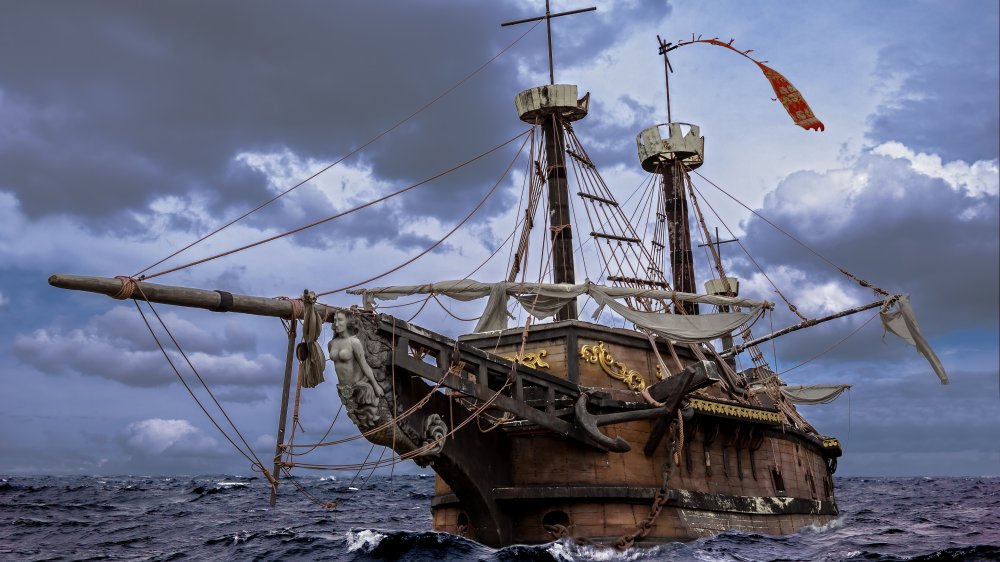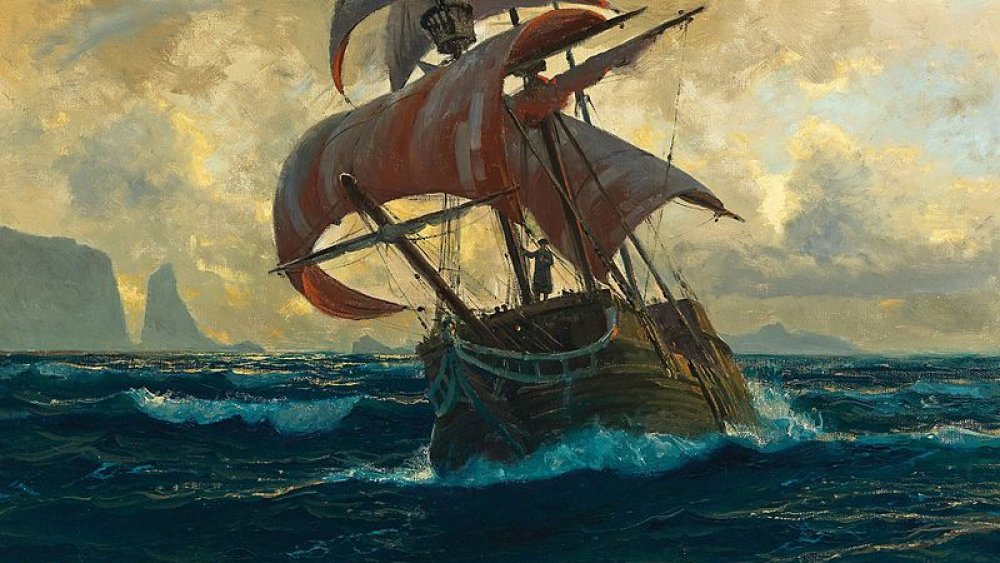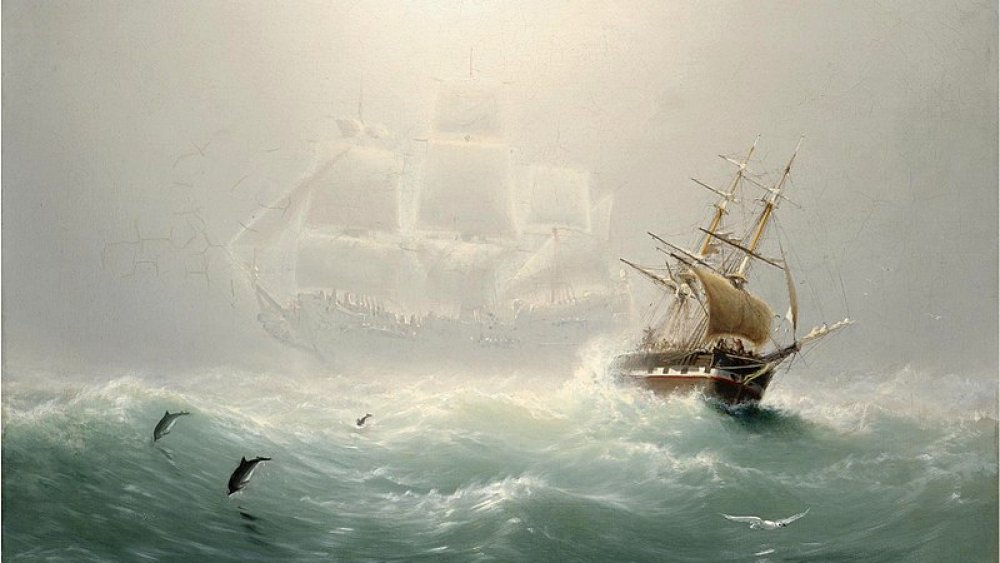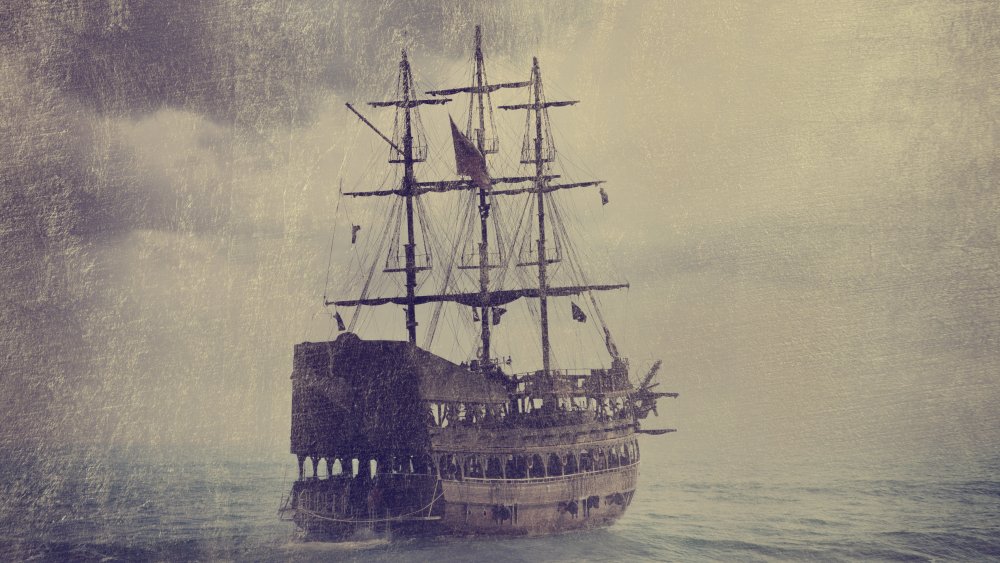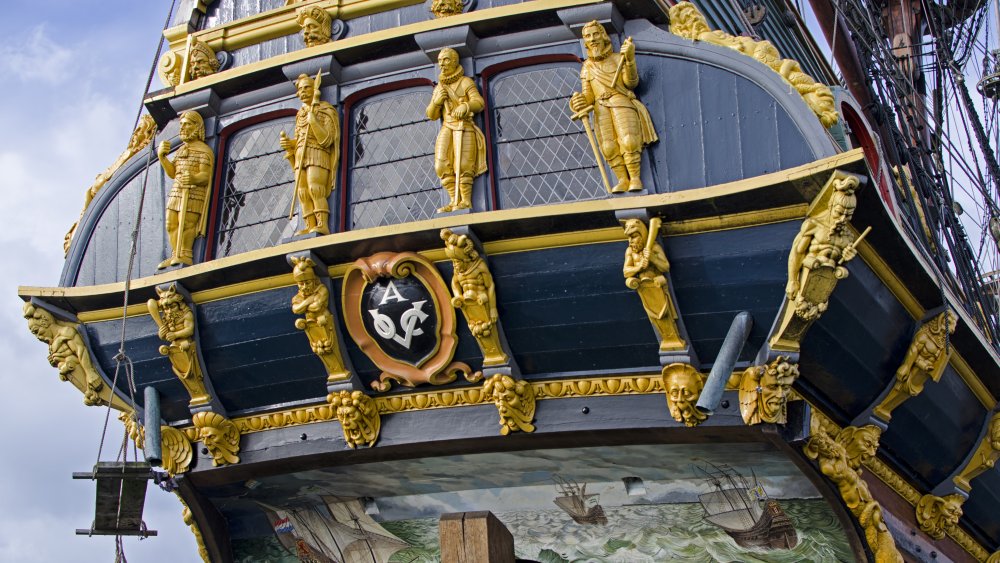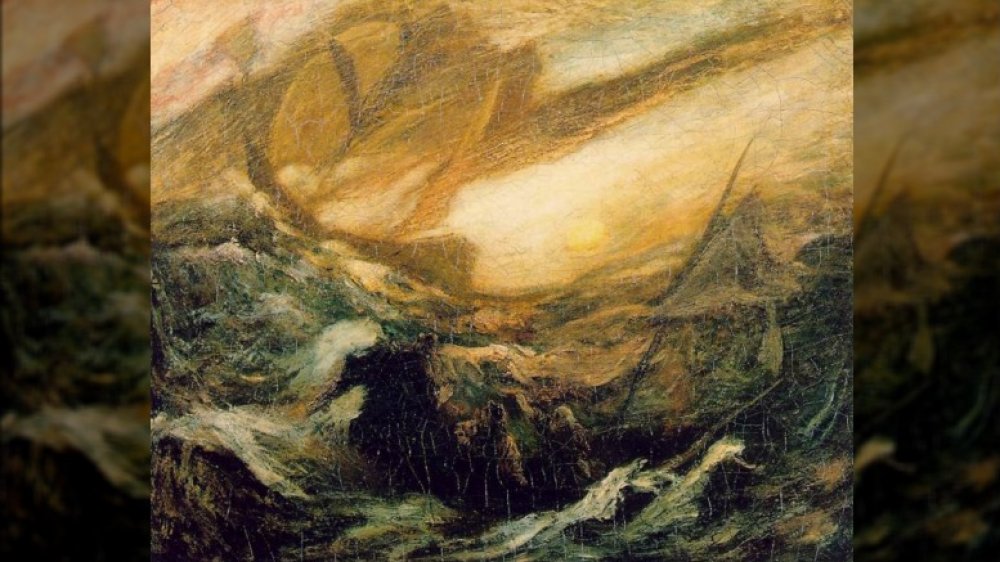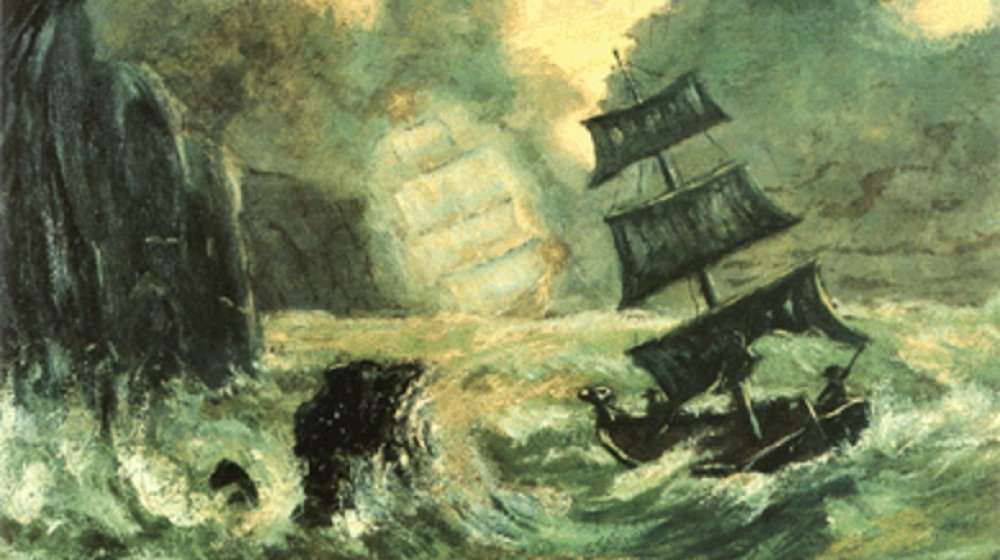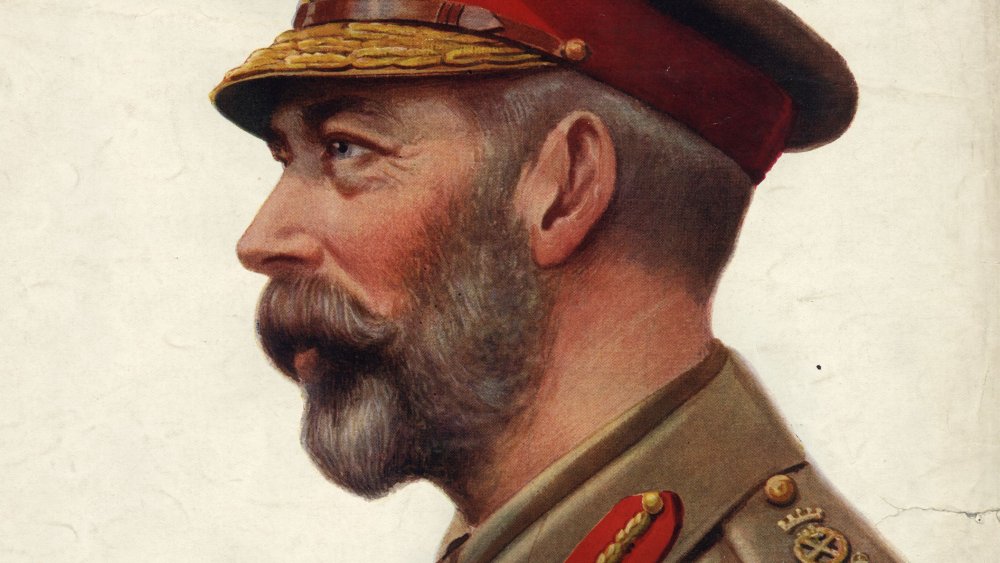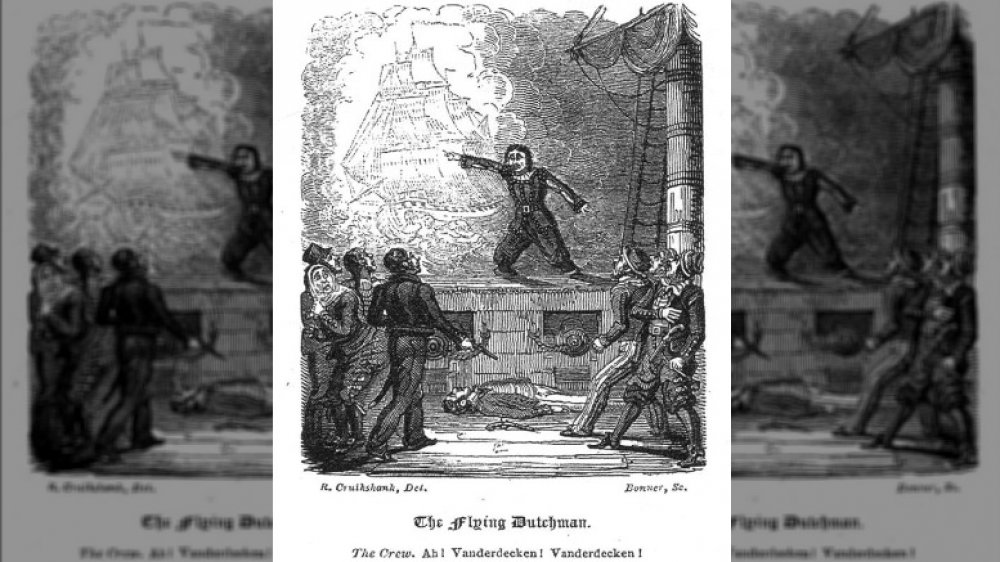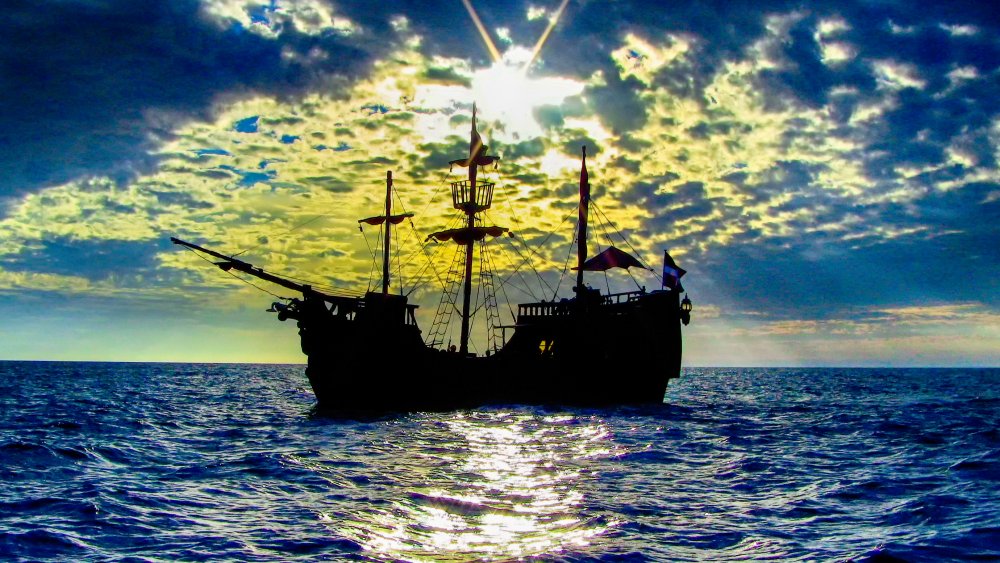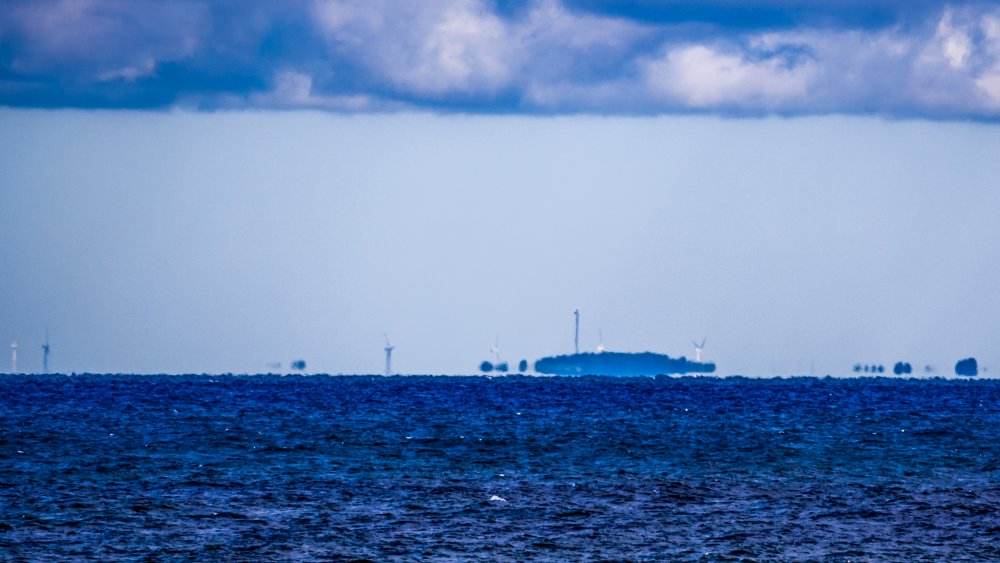The Legend Of The Flying Dutchman Explained
In this modern, 21st century world, we like to pride ourselves on knowing lots of things that our ancient ancestors had no clue about. We're proud of knowing how germs and indoor plumbing work, what makes a rainbow, and why the sky turns all different kinds of colors. But as much as we know, there's one place that's still a terrifying mystery: the ocean.
According to the National Ocean Service, a shocking 80 percent of the world's oceans are unmapped and unexplored... as of 2020. Now, just imagine what we knew 400 years ago, and how much courage it took to head out onto the open seas — especially when you had every reason to believe you were sharing it with ships like the Flying Dutchman.
Sailors have always been a superstitious bunch, putting their faith in all kinds of omens signifying good luck or bad. And one of the most notorious omens of all was the appearance of a ship, doomed to sail the seas for eternity. People — from the lowliest sailor to a future king — claimed to have seen the Dutchman and suffered the curse. So, where did the story of a doomed captain, his crew, and his ship begin? And is there anything to the story? Surprisingly... they almost certainly saw something.
The Flying Dutchman legend starts with the failure of a captain
First, let's talk about the tale told by sailors all over the world, across the centuries. According to the story (via History Collection), the Flying Dutchman started out as a ship owned by the Dutch East India Company. For anyone not up on their history, they were the seafaring merchants behind a huge portion of the trade between Europe and the East Indies.
In 1641, Hendrick Van der Decken was captain of the Dutchman, and it was on his return trip to Europe that things went sideways. In the original tale, they had reached the Cape of Good Hope at the same time as a storm. The crew wanted to turn back, but the captain refused — declaring he was going to sail the waters (which were treacherous at the best of times) and no storm was going to stop him. (In all fairness, some versions of the story have him trying to find a safe port, and failing.)
The crew — realizing their captain was either drunk or mad — decided to mutiny. It didn't go well, though, and Van der Decken killed the leader of the mutineers. Throwing the sailor overboard, he declared that he was going to make the journey even if it took him "until Doomsday," and, well, that's not the sort of commitment you make unless you mean it. His boast was heard, and he and his remaining crew were condemned to sail the seven seas "until Doomsday."
Offending the angels and a deal with the devil
Legends often vary with the telling, and there's two different versions of just how the Captain and his crew were cursed. According to one (via History Collection), after Van der Decken declared he was well and happy to sail until Doomsday if that's what it took, an angel appeared on the deck of the ship. The angel actually gave him a take-backsies, and asked him if he really wanted to be making those kinds of promises. He said it again, and that's when the angel granted his wish. His fate — along with the fate of his crew — was sealed. (In some versions, notes Unsolved Mysteries of the Sea, it's said he was so brazen he even fired his pistol at the angel, and that never works out well for anyone.)
There's also another version, though, and this time, it's the Devil who appears on deck before the captain. The Devil gave him something else — a way to end the curse. If Van der Decken can find the love of a good and faithful woman, he'll be considered to be redeemed, and the curse will be lifted. To that end, he's allowed to return to land once every seven years to try to find such a woman... but given the hundreds of years the ship's been sighted for, it's safe to say that his lady-love was very hard to find.
There are other similar versions of the Flying Dutchman tale
The same basic idea — a ship and her captain condemned to an eternal torment — is also told and retold featuring a Captain Falkenberg. He's said to have been cursed to sail the North Sea until the end of days, locked in a never-ending dice game with Satan himself.
According to Unsolved Mysteries of the Sea, that's the tale that inspired Samuel Coleridge's The Rime of the Ancient Mariner, a poem about a captain who kills an albatross and is punished by becalmed seas. With no water, he's forced to drink his own blood to wet his mouth enough to warn of a ghostly ship approaching, a ship carrying Death and Life-in-Death. The captain begins to play dice with them for the lives of his crew and, one by one, they die. The captain rediscovers his faith at the last moment, and falls into a trance. When he wakes, the dead bodies of his sailors have been reanimated by angels, and they guide him to safety. His compulsion isn't to sail the seas forever, but to share his realization with others, that all God's creatures deserve love and reverence.
The Norse also had a similar tale: in the saga of Stote, there's an episode where a Viking stole a ring from the gods and when they caught him... well, the story ends with the skeletal Viking wreathed in flames and lashed to the mast of a longship.
The other Flying Dutchman
There's one more real-life sea captain who's linked to the tale of the Flying Dutchman. His name was Bernard Fokke, and he was something of a legend in his own time. He did, indeed, work for the Dutch East India Company, and he was notorious for making his journeys faster than anyone else. Skeptoid found that he had an incredibly long career: he was born in 1600 and set his fastest trip time in 1678, and it's no wonder he was connected to the legend.
While Find A Grave says it's not known where he died — he's officially listed as "Buried or Lost at Sea," — and he was never connected to the story of the Flying Dutchman when he was alive. There's no evidence he was ever even called the Flying Dutchman and it's only later storytellers that made the connection, but hey, why let a little historical accuracy get in the way of a good story?
But we can't let him rest without a little final bit of trivia — how did he make those trips so fast if the devil wasn't involved? It's thought he had his ship fitted with iron yardarms instead of the traditional wood, which would have allowed him to sail straight through storms other captains needed to wait out. Sounds like perfect Flying Dutchman material!
The tales of a petty thief
According to The Museum of Fictional Literary Artifacts, the first time the legend of the Flying Dutchman was recorded in print was in a book called A Voyage to Botany Bay. It was published in 1795 by George Barrington, and his story? It's a doozy.
Barrington was born in County Kildare, Ireland in 1755. After stabbing a fellow classmate when he was 16, he turned to pickpocketing, which he was incredibly good at. He eventually headed off to England, where he sweet-talked his way into the upper echelons of London society, then promptly robbed them blind. Not surprisingly, he was eventually arrested and sentenced to transportation to an Australian penal colony... was paroled, and then the whole thing happened again. He pleaded that his 5-year sentence of hard labor was too severe, and it was agreed that he would exile himself from England. He didn't... not immediately. It wasn't until 1791 that he found himself on a convict ship bound for Australia.
His book came out four years later, after he was pardoned. His version of the Flying Dutchman legend went like this: he'd heard tell of two Dutch ships, and as they were returning to England, one sank in a storm around the Cape of Good Hope. The second ship made it home safely, and when they made their next run and sailed back through the cape, they saw the sunken ship sailing alongside them again. They called it the Flying Dutchman, and the name stuck.
Stormy sightings of the Flying Dutchman
Many of the sightings of the Flying Dutchman were recorded around the Cape of Good Hope, but comparing notes between the sightings, it seems as though there were certain conditions that made it more likely the ship would appear. It was almost never sighted in favorable conditions, and while it was occasionally seen moving at an incredible speed through calm waters, it was more often spotted when there were storms kicking up.
According to Marine Insight, many sailors caught glimpses of the Dutchmen through heavy rains and brutal winds, and more than a few sightings claim to have seen it heading toward the rocks before simply vanishing. Others saw it moving through heavy fog or sailing along on brutally choppy waves.
So, it's not surprising that the Flying Dutchman became a harbinger of doom. Sailors who were unfortunate enough to see her believed it meant an ill omen was on the horizon, and worse still was when the ghostly ship tried to make contact.
'Please... just deliver this for us...'
In 1821, an account published in Blackwood's Edinburgh Magazine (via the University of Pittsburgh) added another terrifying layer to the tale — sometimes, the crew of the Dutchman tried to reach out to passing sailors.
It tells the story of a ship rounding the cape, only to see another ship illuminated by lightning. The sailors whisper of the Flying Dutchman, and say that no matter what, they need to keep their distance from the ship. They've heard she brings more than bad weather — if the captain sees someone else, they say, he'll sail hard to get alongside a ship crewed with the living. And as lightning continued to flash, they saw the Dutchman getting closer, and before they knew it, one of the men was on the deck of their ship. He had letters in his hand, from their own Captain Van der Decken, to his friends in Europe.
They've been trying to get someone to take the letters for longer than they can remember, but carrying the letters of the dead is inviting bad luck onto the ship. The living captain tells them that even if they did find someone to take the letters, there was likely no point — they've been sailing for so long that everyone they know and love in Amsterdam is dead. The sailor, refusing to believe it could possibly be true, leaves the letters behind and disappears. The captain ordered they be boarded over, so no living man touched them.
When the Flying Dutchman was spotted by a future king
One of the most intriguing sightings of the Flying Dutchman isn't by any ordinary sailor, it's by the man who would become King George V. His sighting came in 1881, when he, his brother Prince Albert Victor, and their tutor were on a ship moored off the Australian coast. They were in the middle of a 3-year world tour, and when they were awakened at 4 a.m., they saw something unexpected. They (either the future king or his brother) wrote in their log (via History Collection):
"A strange red light as of a phantom ship all aglow, in the midst of which light the masts, spars, and sails of a brig 200 yards distant stood out in strong relief as she came up on the port bow. The officer of the watch from the bridge clearly saw her, as did the quarterdeck midshipman, who was sent forward at once to the forecastle; but on arriving there was no vestige nor any sign whatever of any material ship was to be seen either near or right away to the horizon, the night being clear and the sea calm."
That is incredibly eerie to say the least, and even stranger? The added a footnote: "At 10:45 a.m. the ordinary seaman who had this morning reported the Flying Dutchman fell from the foretopmast crosstrees [...] and was smashed to atoms."
Ordinary sailors have claimed to see the Flying Dutchman... a lot
Sightings of the Flying Dutchman have been recorded in ships' logs from the 18th century, and it was still being spotted well into the 20th century. There's plenty of eerie tales, like that told by the crew of the HMS Leven. She was being accompanied by the HMS Barracouta around Africa in 1823, but at Algoa Bay, the Barracouta had to stop for repairs. The Leven continued on ahead and not long after, the Leven's captain spotted what he thought was the Baracouta, gaining on them. It wasn't — the ship trailing them was suddenly engulfed in mist, and it vanished (via Cape Point South Africa).
And strangest of all, it's not just sailors who have claimed to see the Flying Dutchman. According to The British South Africa Annual (via Sailing's Strangest Moments), around 60 people hanging out on the False Bay beach in 1939 saw the Dutchman, sailing straight for land. The newspapers reported: "Just as the excitement reached its climax, however, the mystery ship vanished into thin air as strangely as it had come."
After that, sightings of the Flying Dutchman seemed to peter out. There are varying reports that suggest sightings ended in the early 1940s (via History Collection), or continued through World War II. Regardless of the precise year, it suddenly seemed that maybe, the captain had finally found his true love.
Yes, they may have truly seen a rare weather phenomenon
With all these sightings of such a similar phenomenon, they had to have seen something, right? Actually, they probably did — and while science hasn't been able to explain the Flying Dutchman beyond a doubt, there's a few explanations that have been put forward to rationalize just what sailors were seeing.
One, says The Irish Times, is St. Elmo's Fire. No one's sure just why St. Erasmus gave his name to the strange weather phenomenon, but we do know that under the right conditions, it can definitely make ships look like they're glowing.
And it's pretty neat. Scientific American says that it happens in stormy weather (like the kind of weather the Dutchman was always spotted in), and it's essentially the same phenomenon you see in neon lights. Electrical charges in the air sort of start a tug-of-war with electrical charges in the ground, and the resulting voltage fractures air molecules. Those molecules start to glow, and since our atmosphere is mostly oxygen and nitrogen, the resulting glow is a blue-violet color... perfect for ghostly ships spotted on the horizon.
They may have seen this incredible phenomenon
Wired says that one possible explanation for the legend of the Flying Dutchman is a completely wild phenomenon called a fata morgana. Named for the enchantress Morgan le Fay of Arthurian legend, the phenomenon... well, it's complicated. In a nutshell, it has to do with the heating of the layers of the atmosphere and the bending of light as it hits the boundary between the layers. Your brain doesn't know that it's looking at bent light and assumes you're looking at something perfectly straight.
That's the principle behind the fata morgana, but the actual fata morgana mirage happens when these conditions all line up to refract an image around the curve of the earth's surface. When that happens, it can actually look like entire cities appear and disappear on the horizon — and oftentimes, they're floating just above the water, like the image pictured — there's actually no buildings there, but you can see the wind turbines, right?
One of the most well-documented instances of the appearance of a fata morgana comes from around the same time period. In 1643, a Jesuit priest named Father Domenico Giardina was looking out across the water from Messina, Sicily, when he saw "a city all floating in the air, so measureless and so splendid, so adorned with magnificent buildings, all of which was found on a base of a luminous crystal." He was seeing a fata morgana and yes, they really can be that detailed. When one appeared over Lake Ontario in the 1890s, the people of Buffalo, New York could count the church spires that towered over Toronto... 50 miles away. Cool? Absolutely.
How Wagner was inspired by the Flying Dutchman... and a storm of his own
Regardless of what all those sailors saw over all those centuries, there's one version of the Flying Dutchman that's still around: Wagner's opera. And according to The Guardian, it all came together in a very appropriate way.
In the summer of 1839, Richard Wagner had just been fired. He'd been working as the music director for Riga's city theater, and that — coupled with his debt, creditors, and the seizure of his passport — meant that in order to get out of town, he needed to pretty much hop a ship and flee the country. Along the way, his ship was caught in a storm. They took shelter first in a fjord in Norway, then in a fishing village. That part of the trip in particular, Wagner would write, "made a wonderful impression on my imagination. The legend of the Flying Dutchman... took on a strange coloring that only my sea adventures could have given it."
The Metropolitan Opera says that it was here that he first read the story — a version of it written by a friend named Heinrich Heine. Wagner became obsessed with the idea of a faithful heroine promising redemption for the doomed sea captain, he wrote his version of the tale — which premiered in 1843.
